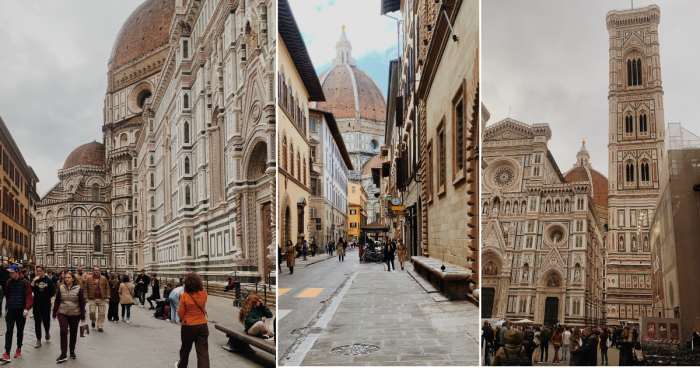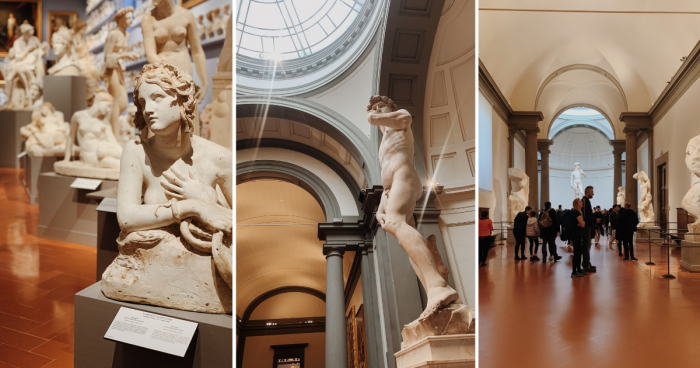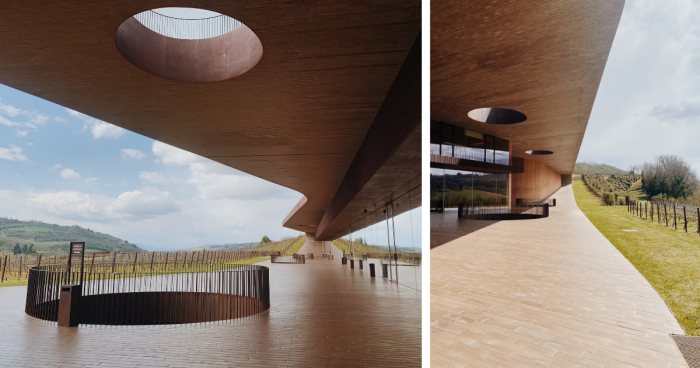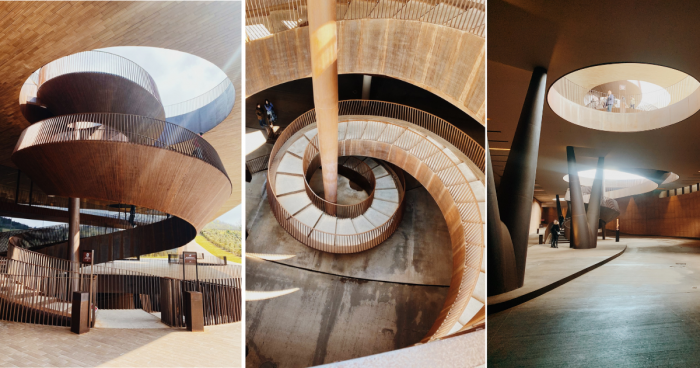
- Permbajtja
- prev
- next
- prev
- next
5 must-see places for architects in Florence (from pikark team)
Travelling feeds your imagination and spirit! We recently wrote an article with 5 quick reasons why architects should travel. ( of course we cut it a bit short ) When we explore new places, it inspires us and helps us be more creative!
We decided to take a short trip to Florence, a city that architects must visit! Here are the top 5 places you must see (according to us).
A city is discovered only by walking Luis Borges
Here are some tips:
it's best to walk around the city, especially if it's a medieval city like Florence! You'll discover more by walking around and exploring the narrow streets that often lead to hidden gems.
Our trip was only three days, and it was the weekend of Catholic Easter, so there were a lot of tourists! We only visited a few museums and attractions because they were overcrowded. We recommend getting a Firenze Card on your next trip because it gives you priority access to many museums and helps you save money.
Here are the top 5 places you must visit on your next trip!
The Florence Cathedral (Duomo di Firenze): This iconic landmark is a must-see for any architect visiting Florence. T
The Florence Cathedral: Santa Maria del Fiore (Duomo di Firenze) is an absolute must-see for any architect visiting Florence. The grand Gothic architecture of the cathedral, including the famous dome designed by Filippo Brunelleschi, is a testament to the skill and creativity of Renaissance architects. Unfortunately, we didn't get to go inside because of the long line (Easter + tourists), but we admired the Gothic cathedral decorated with marble panels in shades of green and pink, framed by white marble facade from the Gothic Renaissance of the 19th century by Emilio De Fabris.

A very attractive facade that was completed around 100 years after the structure was built in 1290 and finalized with the mysterious dome by Brunelleschi. A cathedral whose construction spans centuries, demonstrating the power of Florence on the international stage.
Despite its grandeur, it's also peaceful and delicate, as seen in the decoration of the facade, setting it apart from other cathedrals built during the same period in Europe. You will definitely be impressed!
02. The Uffizi Gallery
The Uffizi Gallery: This world-famous art museum is housed in a beautiful Renaissance-era building designed by Giorgio Vasari. The architecture of the building is itself a work of art, with intricate arches and frescoes adorning the walls and ceilings.
This world-renowned art museum is located in a very beautiful Renaissance-era building from the XVI-th century. designed by Giorgio Vasari
The Uffizi Gallery in Florence, Italy was originally built as a government office complex, called the Uffizi, in 1560. The word "Uffizi" means "offices" in Italian. It was commissioned by Cosimo I de' Medici, the Grand Duke of Tuscany.
The Uffizi served as offices for the Florentine magistrates, administrative offices for the Grand Duchy of Tuscany, and eventually as a police station. It wasn't until the 18th century that the building was transformed into a museum to house the Medici family's art collection. Today, the Uffizi Gallery is one of the most important art museums in the world, with an extensive collection of Renaissance masterpieces.
An architecture capable of modulating spaces and constantly renovating itself though maintaining an enduring majestic sign.

The building's architecture is a work of art in itself, with complicated arches and frescoes adorning the walls and ceilings.
An architecture capable of modulating spaces and constantly renovating itself though maintaining an enduring majestic sign
You will be seeing works by Michelangelo and Raphael, Leonardo da Vinci, Titian or Caravaggio, so best of the Renaissance art and the corridors offer an impressive view over the Arno River and the city of Florence itself.
There are many incredible artworks to see at the Uffizi Gallery in Florence, but some of the most famous and highly regarded include:
- The Birth of Venus by Sandro Botticelli
- Primavera by Sandro Botticelli
- Annunciation by Leonardo da Vinci
- Madonna and Child with Two Angels by Fra Angelico
- The Doni Tondo by Michelangelo
- Bacchus by Caravaggio
- Medusa by Caravaggio
- Venus of Urbino by Titian
- Adoration of the Magi by Gentile da Fabriano
03. La Galleria dell’Accademia di Firenze
David is one of the most beautiful sculptures in the world, created by Michelangelo in 1502-1504. If you want to understand why, then a visit to the Galleria dell'Accademia is a must. You'll be mesmerised by its grandeur, perfection, and attention to the smallest carved detail from a marble block that stands about 15.7 meters tall.

The Galleria dell'Accademia in Florence exhibits the largest number of Michelangelo's sculptures in the world. The gallery was founded in 1784, when the Grand Duke of Tuscany, Pietro Leopoldo, re-organized the Academy of Design in Florence, which had been established in 1563 by Cosimo I de' Medici, into the modern Academy of Fine Arts. The new institution occupied the spaces of the XIV- century o hospital of San Matteo and the monastery of San Niccolò di Cafaggio. However, the pivotal event in the museum's history was the transfer of Michelangelo's David from Piazza della Signoria in August 1873. The world's most famous sculpture waited for nine years in a wooden box for the construction of the Tribune designed by architect Emilio De Fabris to place it in. The current Galleria dell'Accademia was created in 1882.
It is very close to The main Chatedral so you can easily access just to be-sure to have previously booked an entry hour.
04. Piazzale Michelangelo
and last but not least...
05. Cantina Antinori
In addition to the historical and cultural heritage, contemporary architecture also deserves a little attention! Therefore, visit the Antinori Winery in Chianti, designed by architect Marco Casamonti, the director of Archea Associati studio who has also designed the Alban Tower (or 4ever green) and the Arena stadium in Tirana.
Cantina Antinori is a wine estate located in the heart of the Chianti Classico region in Tuscany, Italy. The estate is owned by the Antinori family, who have been producing wine for more than six centuries.
The perfect fusion of nature with delicate and sustainable architecture, where everything is inspired by the vineyards and hills of Chianti. Submerged underground, invisible and perceptible only from one open side facing the vineyards, distinguishable by the main stairs that become the most prominent element brought to life by human movements. Local materials, understanding the context, architectural composition, and above all, good wine make it an attractive spot for architects and wine lovers.

Architects may find the Cantina Antinori winery fascinating because of its innovative design and use of sustainable materials. The winery is built into the hillside, allowing it to be almost invisible from a distance. The structure's facades are covered with terracotta louvers, which create an interesting play of light and shadow, and regulate the internal temperature of the building. The building's interior features large open spaces, including a tasting room, wine shop, and a cellar, all designed to showcase the winemaking process and the products. The winery is also equipped with the latest technology, ensuring efficient and sustainable energy use.

If you have more time, take a longer tour of Tuscany, and you will understand how inspiring the landscape is...
But a trip is never complete without experiencing the culinary side.
We also provide three restaurant suggestions:
- Cinnto Cucina in Torre
- Antica Osteria Rosso
- 3dddi
- Ristorante bel Sogiorno (after visiting the Antinori Winery.)
Of course, we have left out important points such as Palazzo Pitti, Palazzo Vecchio, Corridoio Vasariano, Basilica di Santa Croce, Boboli Gardens, etc., which we will bring up in a second moment, but we are also waiting for suggestions from you!
Which city have you visited, and for which city would you like us to create such a summary?
Piazzale Michelangelo is one of the most iconic places in Florence, Italy. It is a large square situated on a hill overlooking the city, offering a breathtaking panoramic view of Florence's most famous landmarks.
One of the main features of medieval cities are the squares. After the narrow streets and alleys which lead not only to important landmarks (usually religious or government buildings), but also to squares where life is developed and celebrated.
In medieval cities, squares played a vital role as a central meeting place for the community, where people could socialize, trade, and attend public events. Today, Piazzale Michelangelo continues this tradition by serving as a popular gathering spot for both tourists and locals alike.
You can't visit Florence and chilling or relaxing at Michelangelo square, where you can enjoy a drink with friends sitting on the steps while admiring the breathtaking panorama of Florence, where you can see masterpieces like Di Uomo, Ponte Vecchio, - Palazzo Vecchio etc and realize how they standout on the fabric of the city.
Make sure you to enjoy the sunset with a drink in hand/ If you haven't run out of energy, you can climb higher (there are some considerable stairs) towards the Abbazia di San Miniato al Monte church. Its construction began in 1018, making it one of the two oldest structures in Florence.
Architects may find a visit to Piazzale Michelangelo fascinating because of the square's unique design and its breathtaking panoramic view of Florence. The square features a wide staircase leading up to a terrace, which offers a stunning view of the city's historic center and its iconic landmarks, including the Cathedral of Santa Maria del Fiore, the Palazzo Vecchio, and the Ponte Vecchio.